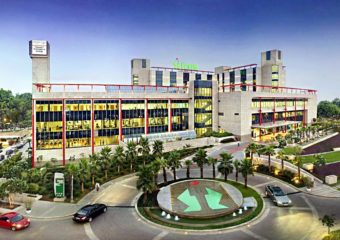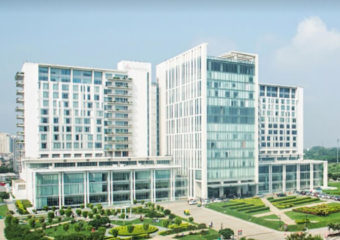Best Robotic Partial Nephrectomy Cost In India
How Much Does Robotic Partial Nephrectomy Cost In India?
Many potential patients for surgery are a concern to know about Robotic Partial Nephrectomy cost In India? The average cost of Robotic Partial Nephrectomy in India starts from $5000. it depends on the hospital charges and the fee charged by the surgeon. This price usually does not cover the post-operational program. Additional costs also involve the diagnostics before the surgery and pre-operational consultations.
What is Robotic Partial Nephrectomy?
Robotic Partial nephrectomy is a surgery preferred for patients with smaller kidney tumors less than 4 cm in size, where in only the tumor and a surrounding rim of the kidney is removed.
However, tumors between 4 and 7 centimeters can also be treated with partial nephrectomy, if they are located in certain areas and technically feasible. It is considered as a treatment option for kidney cancer that has not spread beyond the kidney.

Robot Assisted Laparascopy surgery is one of the most advanced method of performing partial nephrectomy as it incorporates the principles of open surgery and applies them to a robotic-assisted, minimally invasive approach. Thus, the precision and dexterity of advanced instrumentation facilitates outcomes comparable to open surgery but with the advantages of a minimally invasive
Why would someone need a robotic partial nephrectomy?
Patients may be candidates for robotic partial nephrectomy if they have a small kidney tumor or when removing the entire kidney could result in kidney failure and the need for dialysis.
Because of recent medical breakthroughs, robotic partial nephrectomy is the preferred method of surgical intervention for patients with smaller kidney tumors <4 cm in size. However, tumors between 4 and 7 centimeters can be treated with robotic partial nephrectomy if they are located in certain areas
Advantages Robotic Partial Nephrectomy
- Improved visualization of surgical field
- Less pain
- Shorter hospital stay
- Quicker recovery
- Better cosmetic resultLpartialNxincisions
- Lower transfusion rates
- Fewer infections
- Fewer wound hernias
What happens before a robotic partial nephrectomy?
You will meet to your surgeon to discuss your pre-admission process, and to ensure you are fit to go ahead with the procedure.
Please inform the team if you are:
- Diabetic
- Have a cough, cold, or any kind of infection.
You must also inform us prior to attending if you are taking any of the following medications:
- Aspirin, warfarin, clopidogrel (these are likely to need to be stopped some days before the surgery).
- Antibiotics
- Bring Your Medical report
Anti-inflammatory medications and certain vitamin supplements can cause increased bleeding so disclose all of your medications and supplements to your surgeon and anesthesiologist.
It is very important that in preparation for your surgery that you stop smoking. Tobacco harms the body’s natural ability the heal itself which is very important after robotic kidney surgery.
Your surgeon will ask you to not eat or drink anything after midnight the night before your surgery. This is to prevent negative effects of the potential nausea that some patients experience due to anesthesia. Your surgeon may instruct you to take your blood pressure medicine the morning before surgery and you may do so with small sips of water.
What happens during a robotic partial nephrectomy?
The nephrectomy procedure varies, depending on how the surgery is performed and how much of the kidney is removed. Variations include:
- Laparoscopic surgery. In this minimally invasive procedure, the surgeon makes a few small incisions in your abdomen to insert wandlike devices equipped with video cameras and small surgical tools. The surgeon must make a slightly larger opening if your entire kidney needs to be removed.
- Robot-assisted laparoscopic surgery. In a variation of laparoscopic surgery, the surgeon uses a robotic system to perform the procedure. Robotic tools require very small incisions, provide better 3-D images during the procedure, and can make fine or complex motions that are similar to what a surgeon’s hand can do in open surgery.
- Open surgery. In an open nephrectomy, the urologic surgeon makes a cut (incision) along your side or on your abdomen. This open approach allows surgeons to perform some surgeries that still can’t be performed safely with less invasive approaches.
- Radical nephrectomy. In a radical nephrectomy, the surgeon removes the whole kidney, the fatty tissues surrounding the kidney and a portion of the tube connecting the kidney to the bladder (ureter). The surgeon may remove the adrenal gland that sits atop the kidney if a tumor is close to or involves the adrenal gland. In some cases lymph nodes or other tissues are removed as well.
- Partial nephrectomy. In a partial nephrectomy — also called kidney-sparing (nephron-sparing) surgery — the surgeon removes a cancerous tumor or diseased tissue and leaves in as much healthy kidney tissue as possible.
Your urologic surgeon will discuss the advantages and disadvantages of robotic or other types of minimally invasive surgery versus open surgery, including issues such as scarring and the time it takes to return to normal activities.
What happens after a robotic partial nephrectomy?
After your Robotic partial nephrectomy, you will be monitored closely by medical experts and treated for post-procedure pain. As stated before, laparoscopic nephrectomies are far less traumatic than open surgery. However, this does not mean it is pain-free. As you recover, you’ll be treated with pain medication and management techniques that are appropriate for you.
You’ll be encouraged to walk around shortly after your surgery to encourage healing, blood flow, and to restore normal functioning. Walking after surgery also helps prevent pneumonia and other complications.
Immediately after surgery, you’ll be given a liquid diet. As you heal and recover from surgery, you’ll be reintroduced to a solid normal diet.
Normal functioning of the body can be maintained by a single healthy kidney. However, it is possible that your doctor will recommend a healthy diet for you to eat when you return home, physical activity, and regular checkups to help preserve kidney function.
Recovery after robotic partial nephrectomy?
Recovery time after the procedure and the length of your hospital stay depend on your overall health and the type of nephrectomy performed. The urinary catheter remains in place for a short time during your recovery.
Expect to receive instructions before leaving the hospital about restrictions to your diet and activities. You may be encouraged to begin light, everyday activities as soon as you feel able, but you’ll need to avoid strenuous activity or heavy lifting for several weeks.
For most patients, these procedures don’t affect quality of life — once you’re completely recovered, you can expect to resume your normal routine and activities.
Most patients are able to return to full activity within 4-6 weeks compared with 8-12 weeks for open partial nephrectomy.
Risks of robotic partial nephrectomy?
Nephrectomy is generally a safe procedure. But as with any surgery, nephrectomy carries a potential risk of complications, such as:
- Bleeding
- Infection
- Injury to nearby organs
- Rarely, other serious problems
Long-term complications from a nephrectomy relate to potential problems of living with less than two complete, fully functioning kidneys. Although overall kidney function decreases after a nephrectomy, the remaining kidney tissue usually works well enough for a healthy life.
Problems that may occur with long-term reduced kidney function include:
- High blood pressure (hypertension)
- Chronic kidney disease
Potential risks and complications depend on the type of surgery, reasons for surgery, patient’s overall health and many other issues, including surgical expertise and experience. For example, With Medicare Spots these procedures are performed by Top Rated urologists with advanced training and extensive experience to minimize the chances of problems related to surgery and assure the best possible outcomes.
For a better understanding of potential risks it’s important that you discuss these issues with your urologic surgeon.
Frequently Asked Questions (FAQ) Robotic partial nephrectomy
Q. What patients are not good candidates for robotic partial nephrectomy?
Q. Patients with very large tumors or tumors invading surrounding structures (e.g. vena cava, liver, or bowel) may be best served by an open approach due to the extent and need for adjacent organ resection. Medical conditions such as severe lung and heart disease may not be able to tolerate a laparoscopic or robotic approach.
Q. What is the difference between a laparoscopic and robotic approach?
A. Both are laparoscopic approaches and the choice of approach is a matter of surgeon preference. Operative times, blood loss, and hospital stays are similar between a pure laparoscopic and robotic technique. These procedures are performed by inflating the abdomen with carbon dioxide gas and placing a laparoscopic lens affixed to a high definition camera into the abdomen to view the internal organs. Conventional laparoscopic surgery involves hand-held instruments, while robotic surgery involves the use of a sophisticated robotic device (called the da Vinci S Surgical Robotic System) with wristed instrumentation to allow the surgeon to dissect within the abdomen while controlling these instruments externally from a surgeon console.
Q. What happens if complications arise and conversion to open surgery is required?
A. Although extremely rare, conversion to open surgery may be required if difficulty with dissection is encountered during the laparoscopic approach. Our surgeons are trained in open surgical approaches as well as laparoscopy and therefore are well equipped to complete the surgery in an open fashion if needed.
Q. What is the overall success rate of robotic partial nephrectomy?
A. Success rate in complete removal of the kidney tumor is similar to open surgical approaches. Prognosis of cancer-free survival is based upon the grade, stage and particular type of your cancer and will be discussed with you by your surgeon following surgery during review of the pathology report.
Q. Will I need further treatment such as radiation or chemotherapy following surgery?
A. For patients with small, incidentally detected tumors on CT or MRI, prognosis remains excellent as most are cured with surgery alone. Rarely, patients are found to have large, invasive cancers that may require adjuvant treatment with medical therapies such as interleukin-2, interferon-alpha, or tyrosine kinase inhibitors. These would be administrated under advisement of a medical oncologists and Radiation Oncologist Currently there is no utility for radiation Therapy or chemotherapy.
Doctors for Kidney Tumor Removal in India

Dr Vikram Sharma
Director , MBBS, MS 30 years of experience Gurgaon , India

Dr Sanjay Gogoi
Director , DNB, MCh, MS, MBBS 20 Years of Experience New Delhi , India

Dr. Rajesh Ahlawat
Urologist, New Delhi, India Chairman, 39 years of experience.



